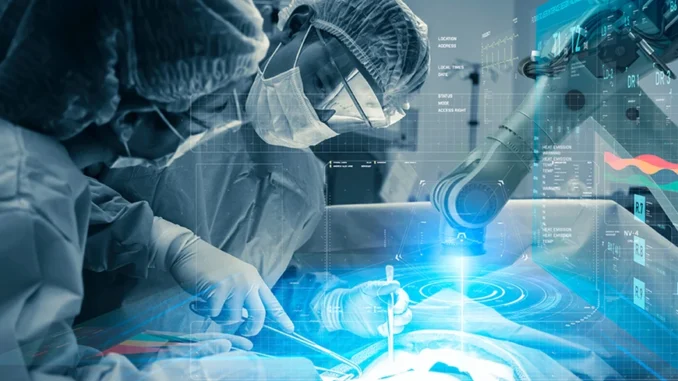

Robotic surgery has revolutionized the way many medical procedures are performed. With cutting-edge technology, robotic systems provide enhanced precision, improved outcomes, and faster recovery times for patients. By combining the expertise of skilled surgeons with advanced robotic assistance, these systems are transforming surgical procedures across various medical fields. This article explores how robotic surgery works, its benefits, and the future of this innovative approach to healthcare.
What is Robotic Surgery?
Robotic surgery involves the use of robotic systems to assist in performing complex surgical procedures with greater precision and control. Surgeons use a console to control robotic arms that hold surgical instruments and cameras, enabling them to perform operations with small incisions, minimal disruption to surrounding tissues, and greater accuracy. Unlike traditional surgery, where the surgeon directly handles the instruments, robotic surgery allows for enhanced dexterity, vision, and stability during procedures.
How Does Robotic Surgery Work?
Robotic surgery typically involves the use of a robotic system composed of several components:
- Surgeon Console: The surgeon sits at a console, which provides a 3D high-definition view of the surgical site. They control robotic arms and instruments using precise movements.
- Robotic Arms: The robotic arms are equipped with specialized surgical instruments that can perform a range of functions, such as cutting, suturing, or cauterizing tissue.
- Endoscope (Camera): A small camera attached to one of the robotic arms provides real-time, high-definition images of the surgical area, enhancing the surgeon’s ability to see delicate structures and make precise decisions.
- Computer Software: Advanced software allows the robotic system to replicate the surgeon’s hand movements with greater precision and control.
This combination of human expertise and robotic assistance allows surgeons to perform minimally invasive procedures that require smaller incisions and offer better outcomes.
Benefits of Robotic Surgery
Robotic surgery offers a range of advantages over traditional open surgery, which often involves larger incisions and longer recovery times. Some of the most notable benefits include:
1. Enhanced Precision
One of the key advantages of robotic surgery is its ability to offer precise control during operations. The robotic arms allow surgeons to make small, accurate movements that would be difficult or impossible with human hands alone. This precision is especially important for delicate procedures, such as those involving the heart, brain, or reproductive organs.
2. Minimally Invasive Procedures
Robotic surgery typically involves smaller incisions than traditional surgery, which reduces trauma to the body. Smaller incisions mean less bleeding, fewer stitches, and a lower risk of infection. Additionally, patients experience less pain and discomfort following the procedure.
3. Faster Recovery Times
Because robotic surgery is minimally invasive, patients often experience shorter recovery times compared to traditional surgery. Smaller incisions lead to less tissue damage, allowing the body to heal more quickly. In many cases, patients can return to their normal activities within a few days or weeks, depending on the procedure.
4. Reduced Risk of Complications
The precision offered by robotic surgery reduces the likelihood of complications during the procedure. Surgeons can make more accurate incisions and avoid damaging nearby tissues or organs. The enhanced visualization provided by the robotic system also helps identify potential issues early, allowing for faster intervention if necessary.
5. Better Visualization
Robotic systems provide surgeons with a 3D, high-definition view of the surgical area, which improves their ability to see fine details. This is particularly beneficial for complex surgeries that require great accuracy, such as those performed on the spine, prostate, or in minimally invasive cancer procedures.
6. Reduced Hospital Stays
Thanks to faster recovery times, patients who undergo robotic surgery often have shorter hospital stays. In some cases, patients can go home the same day as their procedure, reducing the time spent in the hospital and the associated healthcare costs.
Common Types of Robotic Surgeries
Robotic surgery is used in a variety of medical specialties, with its applications continuing to expand. Some common procedures performed using robotic assistance include:
1. Prostate Surgery
Robotic surgery has become the standard for prostate cancer treatments. The robotic system offers high precision when removing the prostate, reducing the risk of nerve damage, which can affect sexual function and urinary continence. The minimally invasive nature of robotic prostate surgery also leads to faster recovery and less pain.
2. Cardiac Surgery
In cardiac surgery, robotic assistance is used for procedures such as coronary artery bypass and valve repair. Robotic surgery allows surgeons to make small incisions between the ribs, minimizing the risk of infection and reducing recovery time compared to traditional open-heart surgery.
3. Gynecological Surgery
Robotic systems are commonly used in gynecological surgeries, including hysterectomies, fibroid removals, and other minimally invasive procedures. These surgeries benefit from enhanced precision, improved visualization, and smaller incisions, resulting in reduced recovery times and less postoperative pain.
4. Spinal Surgery
Spinal surgery can be particularly challenging due to the delicate nature of the spine and surrounding structures. Robotic-assisted spinal surgeries allow for precise alignment of screws and implants, reducing the risk of complications and enhancing outcomes for patients undergoing spinal fusions or decompression procedures.
5. General Surgery
In general surgery, robotic systems are used for a variety of procedures, including gallbladder removal, hernia repair, and colorectal surgeries. These procedures benefit from robotic precision, shorter hospital stays, and faster recovery times, making them safer and more efficient for patients.
The Future of Robotic Surgery
The future of robotic surgery holds tremendous promise as technology continues to advance. Some key trends and potential developments include:
1. Artificial Intelligence Integration
Artificial intelligence (AI) is expected to play a larger role in robotic surgery. AI can analyze data during surgeries, provide real-time guidance to surgeons, and assist in decision-making. AI-driven robotic systems may help further improve precision, reduce errors, and assist in complex procedures.
2. Expanded Applications
While robotic surgery is already used in many areas of medicine, its potential applications are still growing. Robotic systems are expected to be used in more specialized surgeries and for procedures that were previously too complex or high-risk for traditional techniques. Innovations in robotic systems will make these procedures more accessible to a broader range of patients.
3. Remote Surgery
Advancements in telemedicine and robotic technology may allow surgeons to perform surgeries remotely, using robotic systems controlled from a distance. This could make high-quality surgical care available to patients in remote or underserved areas, bridging the gap between medical professionals and those in need.
4. Enhanced Patient Experience
As robotic systems become more refined, patients will benefit from even better outcomes, shorter recovery times, and fewer complications. Future developments will continue to improve the patient experience, making surgeries safer, more efficient, and less invasive.
Conclusion
Robotic surgery is transforming the landscape of modern healthcare, offering numerous benefits such as increased precision, faster recovery, and reduced risk of complications. With its ability to perform minimally invasive procedures with greater accuracy, robotic surgery is becoming a preferred option for many types of surgeries, including prostate, cardiac, gynecological, and spinal procedures. As technology continues to evolve, the future of robotic surgery promises even greater advancements, making surgeries safer and more accessible for patients around the world.
For those undergoing surgery, robotic-assisted procedures offer a promising option for improved outcomes and a quicker return to normal life. As more hospitals and medical centers adopt robotic technology, the potential to improve patient care and reduce healthcare costs is immense, making robotic surgery an essential component of modern medical practice.

Leave a Reply